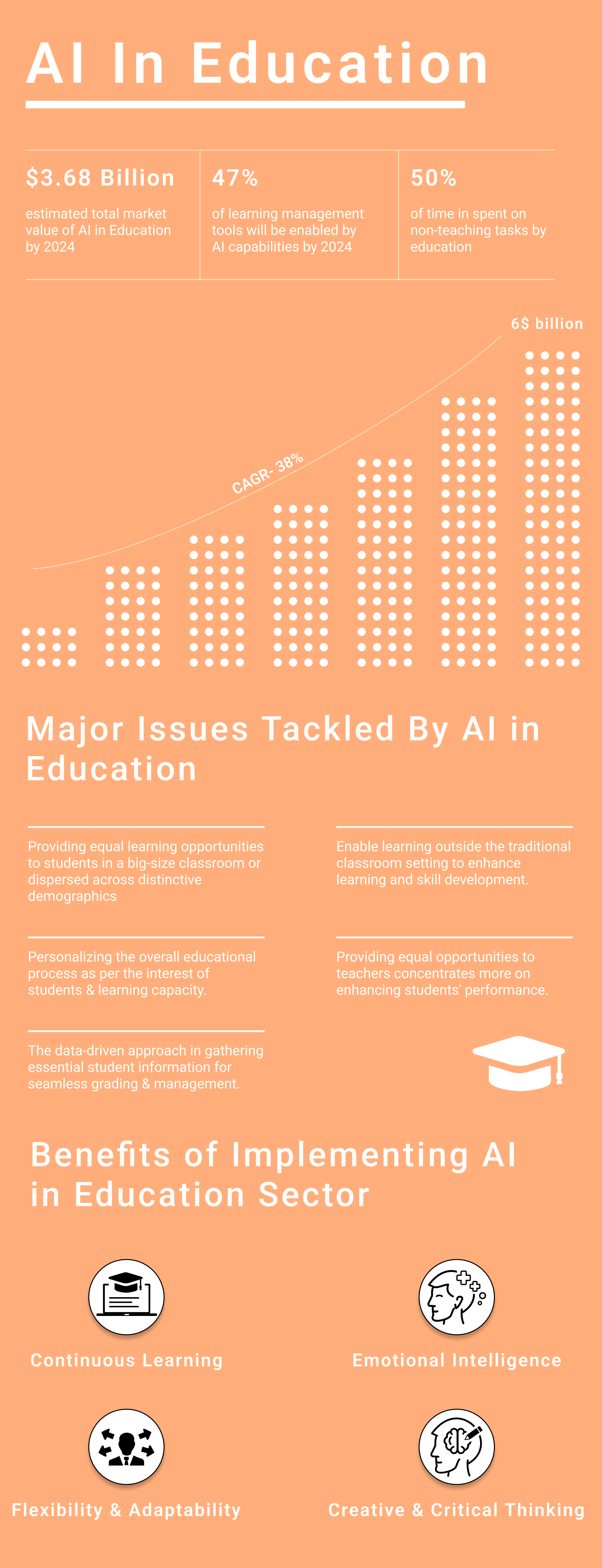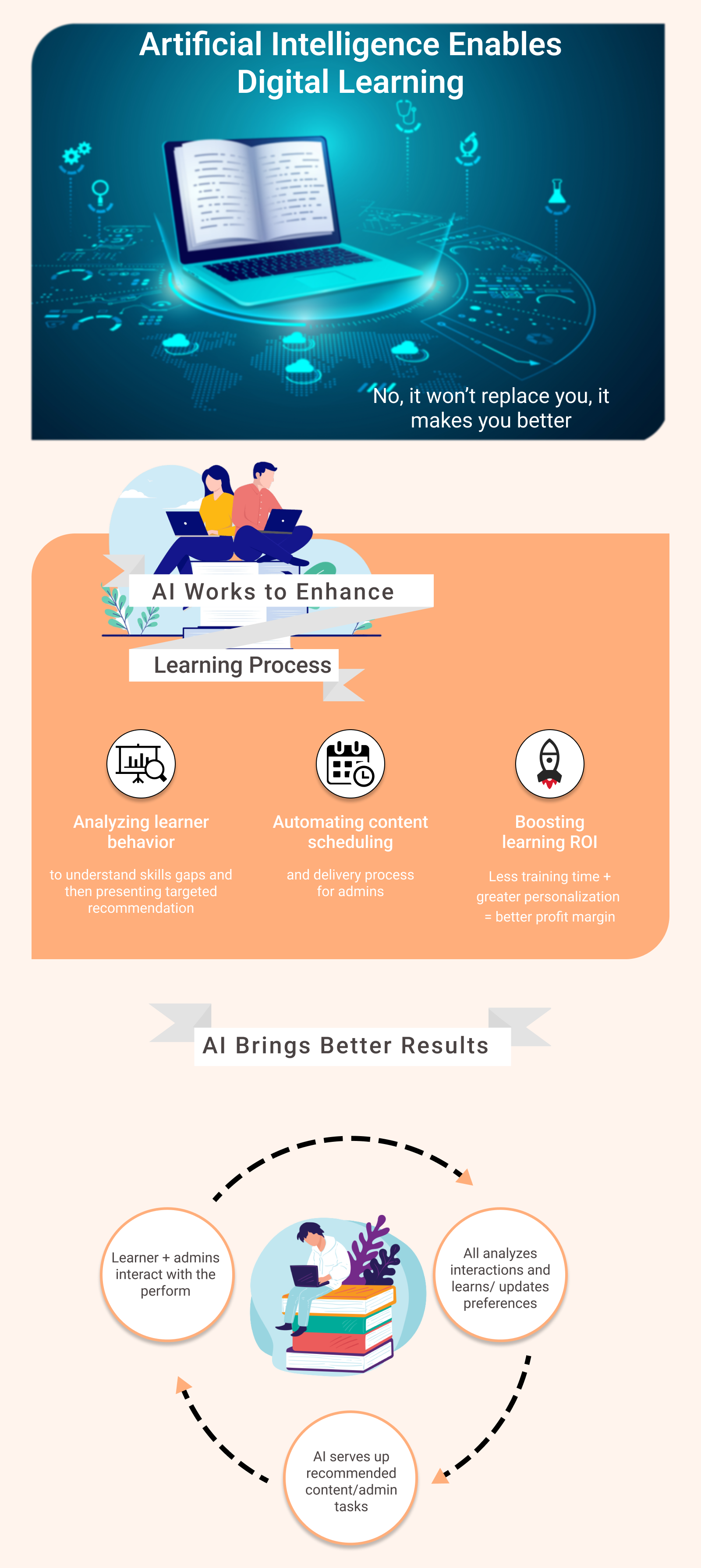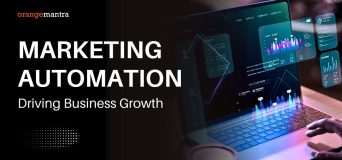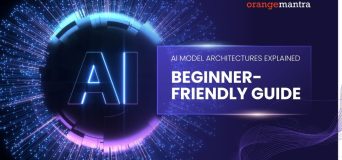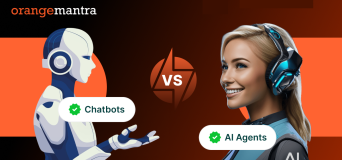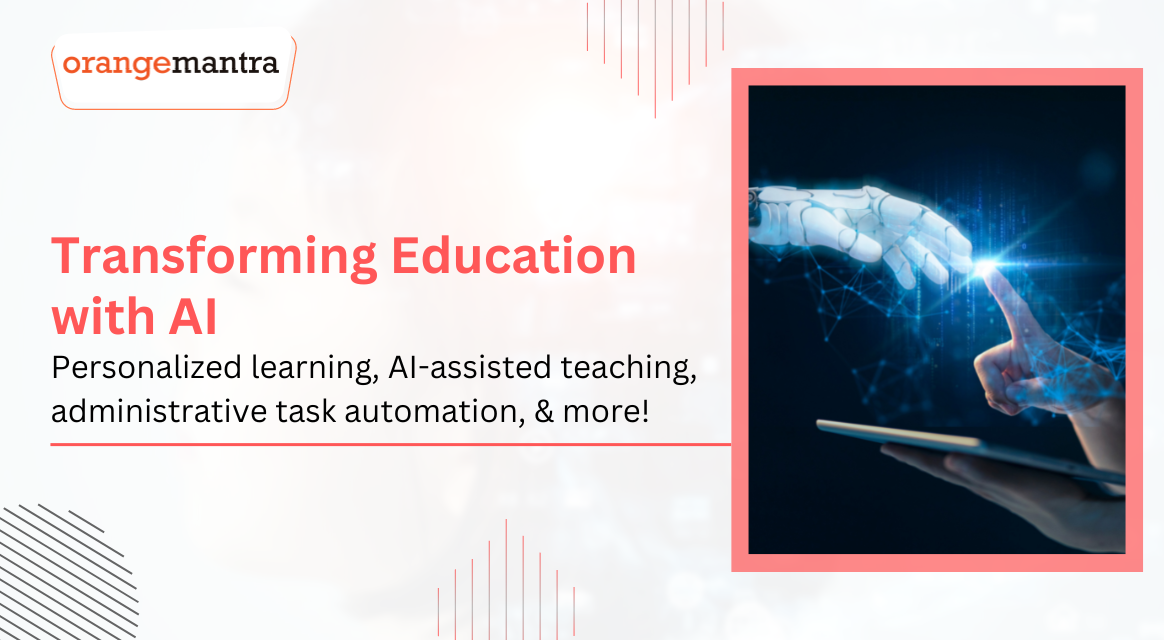
Here’s what you will learn:
A growing number of industries are using AI due to its ability to expedite business growth using various processes that are otherwise not in human capacity. AI solutions have penetrated the Ed-tech space for quite a while now. But the sector has been slower in adopting them. However, the Covid-19 pandemic substantially transformed the learning landscape, leading toward virtual pedagogy.
As we know, the education industry was worst hit as schools and colleges remained closed for more than 2 years, adversely impacting students’ learning and growth. It is a well-known fact that artificial intelligence solutions can innovate the education system, allowing students to learn with greater accuracy and efficiency.
Table of Contents
AI Solutions for the Education Market
The use of AI in education to reach 5.80 billion dollars by 2025. By 2027, the Ed-tech market is estimated to cross 20 billion USD. The graph below illustrates the penetration of AI in the education industry, ranging from 2016 to 2027.
With the increasing use of AI solutions in education, there are distinct ways it is used to help students learn. Here are some noteworthy applications of AI that are transforming the education industry:
AI-Driven Transformations in Education
-
Customized learning
Customization is one of the emerging trends in education. Every student has a unique learning capacity. The traditional learning approach does not focus on customization. And this is where AI proves to be a game-changer. With AI usage, students can avail customized approach to learning based on individual experiences and preferences.
As AI ensures customization of educational software as per every student’s requirement such as level of knowledge, learning speed, and desired objectives. This AI-tailored approach allows to analyze past learning records of the students, identify weaker areas, and offer the best courses for improvement, providing many avenues for customized learning experiences.
-
Administrative-task automation
As per the Telegraph survey, teachers invest 31% of their time doing administrative work, planning tests, replying to general questions, and grading lessons. AI enables automation of such mundane manual tasks, providing teachers with more time to focus on teaching core competencies. Task automation makes the learning environment more productive and efficient.
-
Chatbots for augmented learning
Chatbot or conversational AI is an efficient tool for teachers to augment the learning experience for their students. Chatbots can help students to grasp knowledge in a more efficient, faster, and engaging manner. Students can use iPads or laptops to chat with the bots designed to address specific subjects.
Chatbot tutors not only help students learn new concepts but also do the analysis if needed. An educational chatbot can help students revise concepts prior to the exams, execute questions around particular topics, or solve general doubts. These chatbots help students develop a relationship like that of a student-teacher.
-
Virtual classrooms
A virtual classroom is an online learning platform that enables teachers and students to connect and collaborate to exchange knowledge. With virtual classrooms, students have access to quality teachers across the globe. In contrast to physical classrooms, virtual classrooms can accommodate a larger number of students at once.
This allows for a higher participation rate and makes knowledge more accessible. The virtual classrooms also help in facilitating immediate interactions as they are synchronous, allowing teachers and learners to attend class at the same time. The virtual classroom makes use of pre-recorded learning materials such as lecture slides, videos, and presentations like offline classrooms.
-
Global access
Classrooms have become accessible to all students through AI tools, irrespective of visual or hearing impairment or language barrier. The presentation translator, a PowerPoint plugin, has real-time subtitles for everything the teacher says.
This unleashes new opportunities for students willing to learn at different levels or learn a particular subject that is unavailable in their school or are absent from schools. AI enables us to break the silos between conventional grade levels and schools.
-
Smart Content
AI enables teachers to design smart and different types of content that make learning more convenient for both teachers and learners.
- Digital classes – Al helps in generating bite-sized learning, digital textbooks, and study guides. These materials are accessible from any device, facilitating remote learning.
- Visualization of information – The conventional pedagogy has its limitations when it comes to the usage of visual elements. AI-driven smart content offers the experience of learning in a visualized 2D-3D web-based study environment in real-time.
- Timely content updates – Al also enables to generate timely upgradation of information to stay updated with time. The users are notified every time a new information is added.
-
Learning Management Systems
In this technological era, it is paramount to stay updated with the ongoing educational trends. One of these trends is the use of LMS. LMS is an AI-based software application used to plan, execute, and evaluate a specific learning process. It offers a centralized system for managing all the activities of a school.
Custom built LMS solutions can be used to assign coursework, track student progress, communicate with students and parents, and generate reports on student performance. This system covers all aspects of a course within one space. It means teachers can assess and provide feedback on any assignment at any time.
It also allows students with instant access to their grades without having to wait till the end of a semester. An AI-wired digital tutor can help students with resolving their doubts and provide them with correct answers. AI allows to build a LMS that can understand how students think and help them learn better. And it’s not just the education sector that’s seeing dramatic AI-driven transformations. Healthcare and other industries, too, are leveraging AI to evolve at a dizzying pace.
Determining & Filling the Classroom Lacunae
Custom AI solutions in education make remote learning easier and more efficient. However, the primary fear remains that AI will replace human tutors causing them to lose their jobs. But this is not completely true. AI is not intended to replace teachers, but rather to supplement them.
AI assists teachers in identifying lacunae within the classroom. For example, AI will identify when students skip specific questions. By notifying the teachers, allowing them to reteach the materials as students have not understood it yet. Thus, making teachers more accountable.
Wrapping up
It is evident that AI is beneficial to both instructors and learners. As artificial intelligence solutions continue to mature, the hope is that AI will close the gaps in learning and tutoring. AI helps in driving efficiency, customization, and streamlining administrative tasks by offering teachers with the time and freedom to impart adaptability and understanding.
By exploiting the best of machines and tutors, the vision of AI in education is to fetch best outcomes for students. Since students in today’s time need to study in an AI-driven future, it is crucial that educational organizations expose students to the technology.
FAQs
1. How Artificial Intelligence solutions are presently used in Education industry?
Post Covid-19, technology used in the classroom has drastically changed. Virtual classrooms have replaced traditional classrooms. As AI is computer-based, connecting to different classrooms across the globe has become possible.
- Learning resources are accessible from anywhere at anytime.
- Time-consuming, mundane tasks such as grading or record-keeping have eased due to AI automation.
- AI chatbots/tutors are available 24*7 for assisting students and parents with their queries.
- Learning is customized and tailored as per each student’s objectives and grasping abilities.
2. Will AI replace human tutors in the future?
Although there are a lot of media stories about AI’s potential to replace human tutors – but the truth is that teaching is more than mere knowledge transfer. Machine learning cannot replace the conventional pedagogy delivered by high-quality tutors.
Instead, AI proves to be a powerful tool to complement the learning process by delivering better, offering customized learning experiences, and unburdening educators of administrative tasks.
3. What exactly is Robotics?
Robotics is a sub-set of AI, composed of computer sciences, mechanical engineering, and electrical engineering to perform programmed tasks without human intervention.
